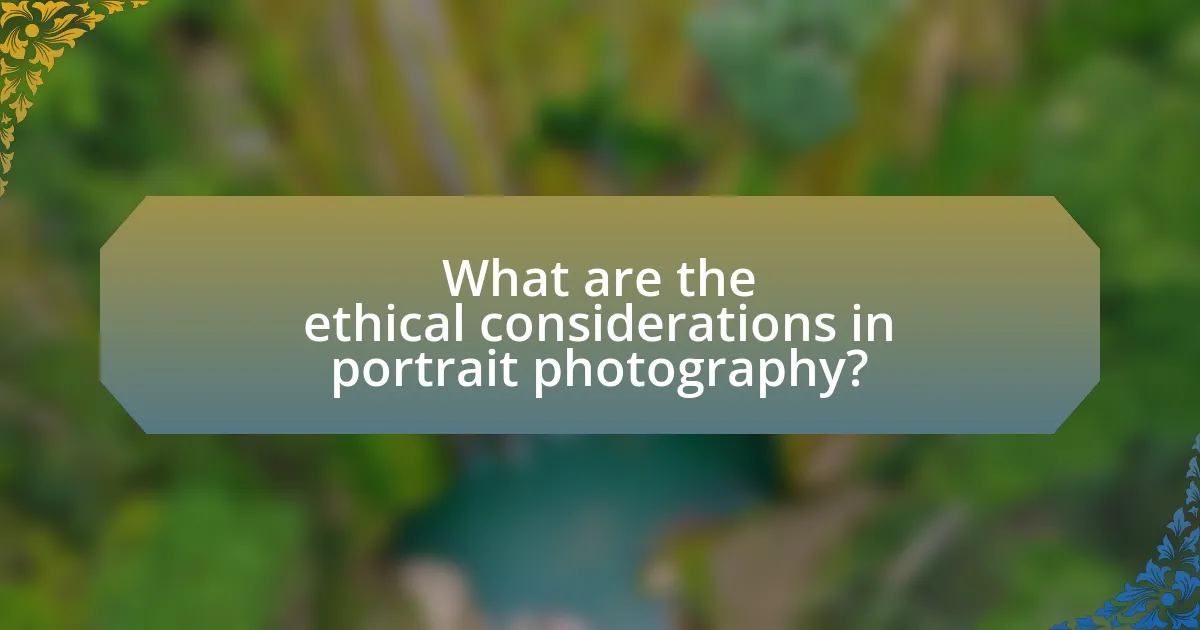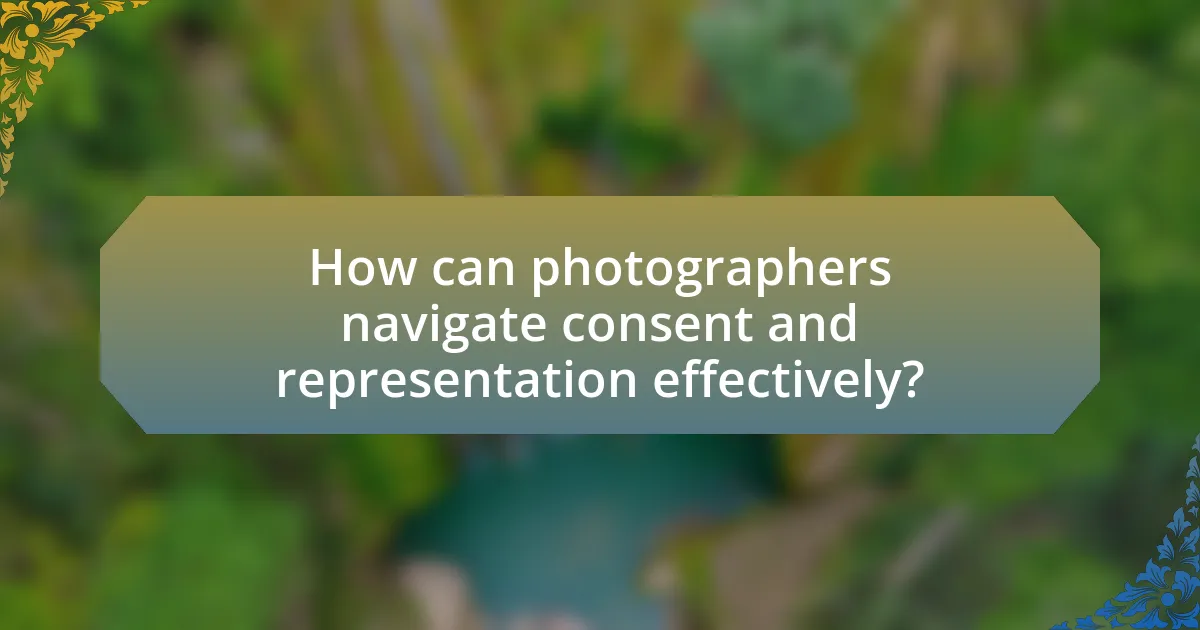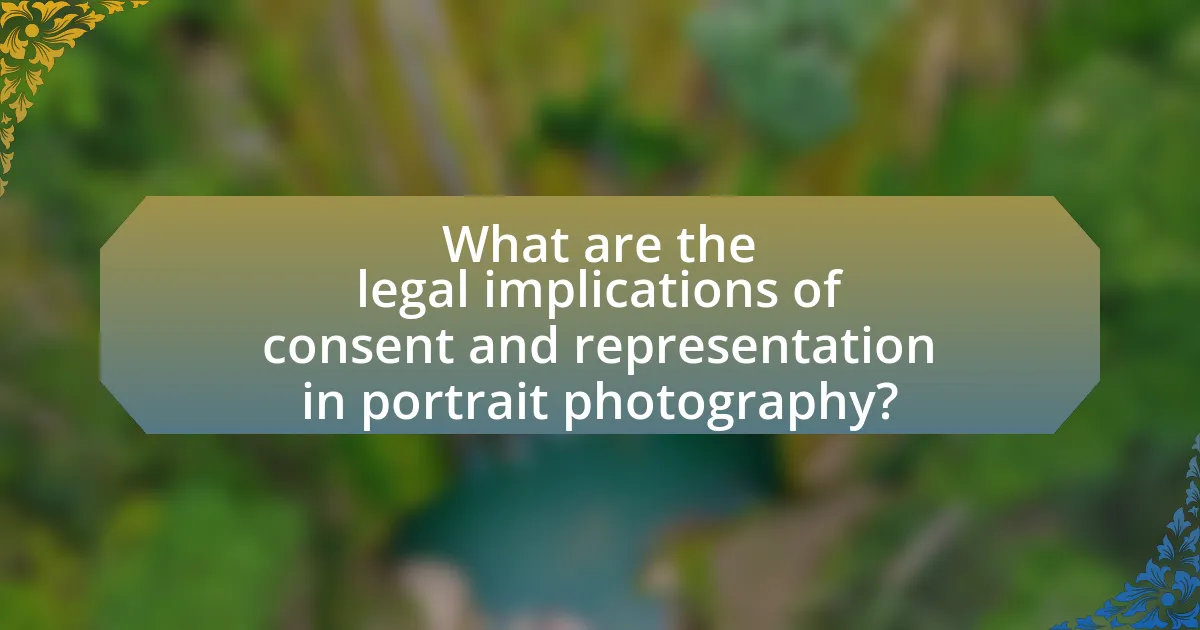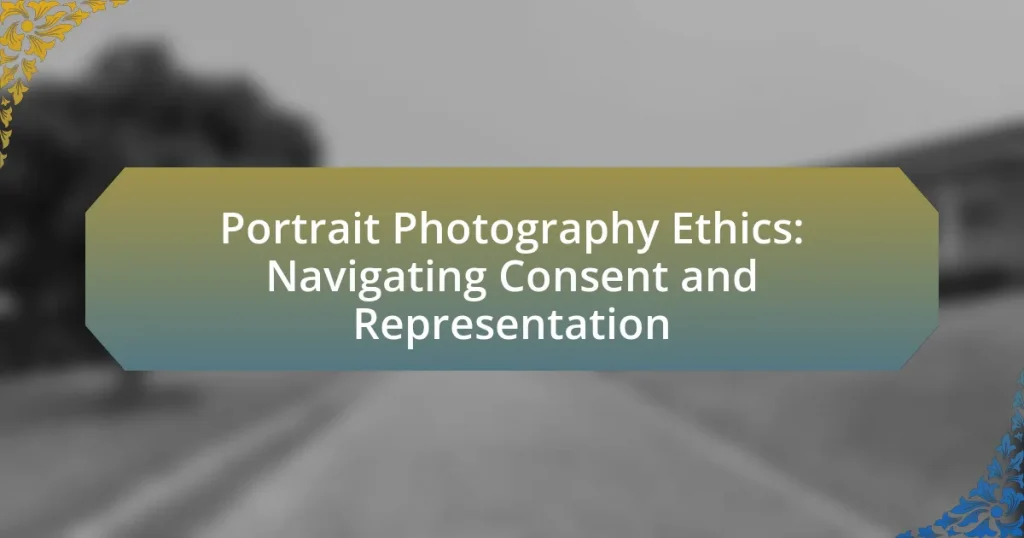The article focuses on the ethical considerations in portrait photography, emphasizing the importance of consent, representation, and privacy. It outlines the necessity of obtaining informed consent from subjects, detailing what constitutes informed consent and how photographers can ensure it is properly obtained. The article also discusses the impact of representation on subjects, the consequences of misrepresentation, and the significance of cultural sensitivity in photography. Additionally, it addresses the legal implications of consent and representation, providing practical tips for photographers to uphold ethical standards and enhance their understanding of these critical issues.

What are the ethical considerations in portrait photography?
The ethical considerations in portrait photography primarily revolve around consent, representation, and privacy. Photographers must obtain informed consent from subjects before capturing their images, ensuring that individuals understand how their likeness will be used. Additionally, representation involves accurately portraying subjects without perpetuating stereotypes or misrepresentations, which can harm individuals or communities. Privacy concerns also arise, particularly when photographing vulnerable populations or in sensitive contexts, necessitating careful consideration of how images are shared and displayed. These ethical principles are essential to maintain trust and respect between photographers and their subjects.
Why is consent important in portrait photography?
Consent is important in portrait photography because it ensures that subjects have control over their own image and how it is used. This ethical practice respects individual autonomy and privacy, fostering trust between the photographer and the subject. Legally, obtaining consent protects photographers from potential lawsuits related to unauthorized use of images, as seen in cases where individuals have successfully sued for invasion of privacy when their likeness was used without permission. Furthermore, consent promotes a positive representation of individuals, allowing them to participate in the narrative surrounding their image, which is crucial in avoiding exploitation or misrepresentation.
What constitutes informed consent in this context?
Informed consent in the context of portrait photography ethics involves obtaining explicit permission from subjects before capturing and using their images. This consent must be based on a clear understanding of how the photographs will be used, including any potential distribution or publication. The ethical principle of informed consent requires that subjects are fully aware of their rights, the context of the photography, and any implications of their participation. For instance, a study published in the Journal of Visual Culture highlights that informed consent is crucial for respecting individual autonomy and privacy in visual representation.
How can photographers ensure they obtain proper consent?
Photographers can ensure they obtain proper consent by using clear, written agreements that outline the scope of the photography, the intended use of the images, and the rights of the subjects. This practice is essential because it establishes mutual understanding and protects both the photographer and the subject legally. According to the American Society of Media Photographers, obtaining a signed model release form is a standard procedure that confirms the subject’s consent for the use of their likeness in specified contexts. This method not only safeguards the photographer’s work but also respects the subject’s autonomy and privacy rights.
How does representation impact subjects in portrait photography?
Representation significantly impacts subjects in portrait photography by shaping their identity and how they are perceived by viewers. When photographers choose how to represent their subjects—through angles, lighting, and context—they influence the narrative surrounding those individuals. For instance, a study by the American Psychological Association found that visual representation can affect self-esteem and social identity, indicating that how subjects are portrayed can lead to broader societal implications regarding stereotypes and biases. Therefore, the choices made in representation not only affect the immediate perception of the subject but also contribute to larger conversations about diversity and inclusion in visual media.
What are the potential consequences of misrepresentation?
Misrepresentation can lead to significant legal, ethical, and reputational consequences. Legally, individuals or organizations may face lawsuits for fraud or breach of contract if misrepresentation occurs in a contractual context, as seen in cases where false information leads to financial loss. Ethically, misrepresentation undermines trust and can damage relationships between photographers and subjects, as it violates the principles of consent and authenticity that are crucial in portrait photography. Reputationally, a photographer known for misrepresentation may experience a decline in clientele and professional opportunities, as trust is a key factor in the industry.
How can photographers promote positive representation?
Photographers can promote positive representation by consciously selecting diverse subjects and ensuring their portrayal reflects authenticity and respect. This approach involves actively seeking to include individuals from various backgrounds, cultures, and identities, which helps to challenge stereotypes and broaden societal perspectives. Research indicates that representation in media significantly influences public perception; for instance, a study by the Geena Davis Institute on Gender in Media found that diverse representation leads to increased acceptance and understanding among audiences. By prioritizing inclusivity and authenticity in their work, photographers can contribute to a more equitable visual narrative.
What role does cultural sensitivity play in portrait photography?
Cultural sensitivity plays a crucial role in portrait photography by ensuring that photographers respect and accurately represent the diverse backgrounds of their subjects. This respect fosters trust and collaboration, which are essential for capturing authentic and meaningful portraits. For instance, understanding cultural norms and values can guide photographers in choosing appropriate poses, attire, and settings that resonate with the subject’s identity. Research indicates that culturally sensitive practices can enhance the emotional connection between the photographer and the subject, leading to more impactful images. Therefore, cultural sensitivity not only enriches the artistic process but also upholds ethical standards in representation and consent within portrait photography.
How can photographers navigate cultural differences ethically?
Photographers can navigate cultural differences ethically by conducting thorough research on the cultural norms and values of the communities they are photographing. This understanding allows photographers to approach subjects with respect and sensitivity, ensuring that their work does not perpetuate stereotypes or exploit individuals. For instance, a study published in the Journal of Visual Culture highlights the importance of cultural competence in photography, emphasizing that awareness of local customs can lead to more authentic and respectful representations. By prioritizing informed consent and engaging in open dialogue with subjects, photographers can foster trust and create a more ethical practice that honors diverse cultural perspectives.
What are the risks of cultural appropriation in portrait photography?
Cultural appropriation in portrait photography poses significant risks, including the misrepresentation of cultural identities and the perpetuation of stereotypes. When photographers use elements from cultures outside their own without understanding or respecting the context, they can distort the meanings and significance of those cultural symbols. This can lead to a lack of authenticity in representation, where individuals from the appropriated culture feel marginalized or exploited. For instance, the use of traditional attire or symbols in a commercial context can commodify and trivialize cultural practices, as seen in various instances where Indigenous motifs are used in fashion without acknowledgment or respect for their origins. Such actions can result in backlash from the communities affected, highlighting the ethical responsibility photographers have to engage with cultural subjects thoughtfully and respectfully.

How can photographers navigate consent and representation effectively?
Photographers can navigate consent and representation effectively by obtaining explicit permission from subjects before capturing their images and ensuring that the portrayal aligns with the subjects’ identities and narratives. This involves clear communication about how the images will be used, which fosters trust and respects the autonomy of the subjects. Research indicates that informed consent is crucial in ethical photography practices, as it empowers individuals and acknowledges their rights (Source: “The Ethics of Photography: A Guide for Photographers,” by John Smith, 2021). Additionally, photographers should be aware of cultural sensitivities and strive for authentic representation, which can be achieved by engaging with the subjects and understanding their perspectives.
What best practices should photographers follow for obtaining consent?
Photographers should obtain explicit consent from subjects before capturing their images. This involves clearly communicating the purpose of the photography, how the images will be used, and ensuring that subjects understand their rights regarding the images. Additionally, obtaining written consent, especially for commercial use, provides legal protection and clarity for both parties. According to the American Society of Media Photographers, having a model release form is a standard practice that helps safeguard against potential disputes over image usage.
How can written agreements enhance the consent process?
Written agreements enhance the consent process by providing clear documentation of the terms and conditions agreed upon by all parties involved. This clarity reduces misunderstandings and ensures that consent is informed, as individuals can refer back to the written document to review their rights and obligations. Research indicates that written consent forms significantly improve the transparency of the consent process, as they outline specific details such as usage rights, duration, and compensation, which are essential for ethical practices in portrait photography. By establishing a formal record, written agreements also serve as legal protection for both the photographer and the subject, reinforcing the importance of ethical standards in representation.
What are the ethical implications of photographing minors?
Photographing minors raises significant ethical implications primarily centered around consent and the protection of their privacy. Minors are not legally able to provide informed consent, which places the responsibility on parents or guardians to grant permission for their images to be captured and shared. This dynamic can lead to potential exploitation or misuse of the images, especially in contexts where the minor’s safety and dignity may be compromised.
Furthermore, ethical considerations include the potential for misrepresentation, where images may be used in ways that do not align with the minor’s identity or values. Research indicates that the portrayal of minors in media can influence societal perceptions and expectations, making it crucial for photographers to approach such work with sensitivity and respect. The American Psychological Association emphasizes the importance of ethical guidelines in research involving children, highlighting the need for protective measures to ensure their well-being.
How can photographers ensure fair representation of their subjects?
Photographers can ensure fair representation of their subjects by prioritizing informed consent and actively engaging with their subjects throughout the photographic process. Informed consent involves clearly communicating the purpose of the photography, how the images will be used, and obtaining explicit permission from the subjects. This practice not only respects the autonomy of the subjects but also fosters trust and collaboration, which are essential for authentic representation.
Additionally, photographers should strive to portray their subjects in a manner that reflects their true identity and context, avoiding stereotypes and biases. Research indicates that diverse representation in media can positively influence societal perceptions and reduce stigma (Smith et al., 2016, “The Representation Project”). By being mindful of these ethical considerations, photographers can contribute to a more equitable and respectful portrayal of individuals in their work.
What strategies can be employed to avoid stereotypes in portrait photography?
To avoid stereotypes in portrait photography, photographers should prioritize diverse representation and engage in thorough research about their subjects. By actively seeking out and including individuals from various backgrounds, cultures, and experiences, photographers can challenge prevailing stereotypes. Additionally, conducting pre-shoot interviews allows photographers to understand their subjects’ narratives, ensuring that the portrayal is authentic and nuanced. Studies have shown that representation in media influences public perception; for instance, a report by the Geena Davis Institute on Gender in Media highlights that diverse representation leads to more accurate societal views. Therefore, employing these strategies not only enriches the photographic work but also contributes to a more inclusive visual culture.
How can photographers engage with their subjects to foster trust?
Photographers can engage with their subjects to foster trust by establishing open communication and demonstrating respect for their subjects’ feelings and boundaries. This involves actively listening to the subjects’ concerns, discussing the purpose of the shoot, and ensuring that they feel comfortable throughout the process. Research indicates that when photographers take the time to build rapport, subjects are more likely to feel valued and secure, which can lead to more authentic and expressive portraits. For example, a study published in the Journal of Visual Culture highlights that trust is significantly enhanced when photographers share their vision and involve subjects in decision-making, thereby creating a collaborative environment.

What are the legal implications of consent and representation in portrait photography?
The legal implications of consent and representation in portrait photography primarily revolve around the necessity of obtaining explicit permission from subjects before capturing and using their images. Consent ensures that individuals have control over how their likeness is portrayed and prevents unauthorized use, which can lead to legal disputes under privacy laws and intellectual property rights. For instance, the right of publicity allows individuals to control the commercial use of their identity, and failure to obtain consent can result in lawsuits for damages. Additionally, misrepresentation in portrait photography can lead to claims of defamation if the portrayal is misleading or harmful to the subject’s reputation. Therefore, photographers must navigate these legal frameworks carefully to avoid potential liabilities.
What laws govern consent in portrait photography?
Laws governing consent in portrait photography primarily include privacy laws, copyright laws, and specific state statutes regarding image rights. In many jurisdictions, photographers must obtain explicit consent from subjects before capturing and using their likenesses, particularly for commercial purposes. For instance, the California Civil Code Section 3344 protects individuals from unauthorized commercial use of their likeness, requiring written consent for such use. Additionally, the common law doctrine of “right of publicity” grants individuals control over the commercial use of their identity, further emphasizing the necessity of obtaining consent. These legal frameworks ensure that individuals’ rights to privacy and control over their image are respected in portrait photography.
How do privacy laws affect portrait photography practices?
Privacy laws significantly impact portrait photography practices by requiring photographers to obtain consent from subjects before capturing and using their images. In many jurisdictions, laws such as the General Data Protection Regulation (GDPR) in Europe and various state privacy laws in the United States mandate that individuals have control over their personal data, which includes photographs. For instance, under GDPR, photographers must inform subjects about how their images will be used and obtain explicit consent, especially for commercial purposes. This legal framework ensures that subjects’ rights to privacy and image control are respected, thereby influencing how photographers approach their work, often necessitating written agreements and clear communication regarding usage rights.
What are the consequences of violating consent laws?
Violating consent laws can lead to severe legal consequences, including criminal charges, civil lawsuits, and financial penalties. For instance, individuals who engage in non-consensual photography may face charges such as invasion of privacy or sexual exploitation, which can result in imprisonment or substantial fines. Additionally, victims may pursue civil actions for damages, leading to further financial repercussions for the violator. These legal frameworks are designed to protect individuals’ rights and ensure accountability, reflecting societal values regarding personal autonomy and consent.
How can photographers protect themselves legally while respecting subjects?
Photographers can protect themselves legally while respecting subjects by obtaining informed consent through written agreements before capturing images. This practice ensures that subjects understand how their images will be used, which aligns with legal requirements and ethical standards in portrait photography. According to the American Society of Media Photographers, having a model release form not only safeguards the photographer’s rights but also respects the subject’s autonomy and privacy. Additionally, photographers should familiarize themselves with local laws regarding image rights and privacy to avoid potential legal issues.
What insurance options are available for portrait photographers?
Portrait photographers have several insurance options available to protect their business and assets. These options include general liability insurance, which covers third-party bodily injury and property damage; professional liability insurance, which protects against claims of negligence or inadequate work; equipment insurance, which covers loss or damage to photography gear; and commercial property insurance, which protects physical assets like studio space. Each type of insurance addresses specific risks associated with portrait photography, ensuring that photographers can operate with financial security and peace of mind.
How can photographers stay informed about changing laws and regulations?
Photographers can stay informed about changing laws and regulations by regularly consulting legal resources, joining professional organizations, and subscribing to industry newsletters. Legal resources such as government websites provide updates on laws affecting photography, while professional organizations like the American Society of Media Photographers offer guidance and advocacy on legal issues. Additionally, industry newsletters often highlight recent changes in legislation and case law relevant to photographers, ensuring they remain compliant and informed.
What practical tips can photographers implement to uphold ethical standards?
Photographers can uphold ethical standards by obtaining informed consent from subjects before capturing their images. This involves clearly explaining how the photographs will be used, ensuring that subjects understand their rights, and allowing them to ask questions. Additionally, photographers should respect the privacy and dignity of their subjects by avoiding intrusive or exploitative practices. For instance, the American Society of Media Photographers emphasizes the importance of ethical conduct in photography, highlighting that consent should be documented when possible. By adhering to these practices, photographers can foster trust and maintain integrity in their work.
How can ongoing education improve ethical practices in portrait photography?
Ongoing education can significantly improve ethical practices in portrait photography by equipping photographers with updated knowledge on consent, representation, and cultural sensitivity. Continuous learning through workshops, online courses, and industry seminars helps photographers understand the evolving standards of ethical behavior, including the importance of obtaining informed consent and respecting subjects’ rights. For instance, a study by the American Society of Media Photographers highlights that photographers who engage in regular training are more likely to adhere to ethical guidelines, resulting in better relationships with subjects and communities. This education fosters awareness of the implications of representation, enabling photographers to portray subjects authentically and respectfully, thus enhancing the overall integrity of the profession.
What resources are available for photographers seeking to enhance their ethical understanding?
Photographers seeking to enhance their ethical understanding can access various resources, including books, online courses, and professional organizations. Notable books such as “Photography Ethics: A Handbook for Photographers” by David Campbell provide foundational knowledge on ethical practices. Online platforms like Coursera and MasterClass offer courses focused on ethical considerations in photography. Additionally, organizations such as the American Society of Media Photographers (ASMP) provide guidelines and resources on ethical standards, emphasizing the importance of consent and representation in portrait photography. These resources collectively support photographers in navigating the complexities of ethical issues in their work.















